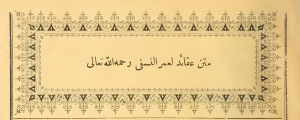How to use this or the logic of the layout where the website creator tells the unsuspecting visitor how to best navigate through the deluge.

The text of creed (ʿaqīda) is a concise set of statements that are best described as a table of contents of a book. Just as in the creed of Ṭaḥāwī (ʿal-aqīda al-Ṭaḥāwiyya) this creed is similar in format. These are very short statements that scholars have agreed upon and we find these exact phrases used time and time again in many of the books on the creed that go into detail.
Abū Ḥafṣ ʿUmar al-Nasafī followed the new school (mutaqadīmīn/khalf) versus the old school (mutʾakhirīn/salaf) of creed. These are more philosophical theology than straight out theology. As will be shown al-Nasafī followed the school of Abū Manṣūr Muḥammad al-Māturīdī (d. 333/944) which is in line with the school of Abū al-Ḥasan al-Ashʿarī (d.324/935-6). They differed on a few fine points of the creed as will be pointed out in the notes.
Each of the statements of the creed are broken up into sentences and for each sentence a “post” exits. There are 51 sentences in total; and that is a loose use of the word sentence here because sometimes its a long sentence and at other times its just 2 or 3 words. I have included the Arabic text and the translation below. In the translation I have included some of the Arabic words in parenthesis written out in transliteration. The Arabic words are all translated as well.
Given that the text is quite concise I went overboard with the Arabic transliteration. I have tried to use the same translation for each Arabic words with very few exceptions if any. In such small work words are not repeated often so it’s easier to do. Given that its a very concise text it’s very hard to translate well.